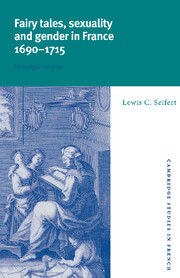Book contents
- Front Matter
- Contents
- Acknowledgments
- Note on translations and quotations
- Introduction
- Part I MARVELOUS STORYTELLING
- Chapter 1 Marvelous realities: toward an understanding of the merveilleux
- Chapter 2 Reading (and) the ironies of the marvelous
- Chapter 3 The marvelous in context: the place of the contes de fées in late seventeenth-century France
- Part II MARVELOUS DESIRES
- Afterword
- Notes
- Selected bibliography
- Index
- Cambridge Studies in French
Chapter 1 - Marvelous realities: toward an understanding of the merveilleux
Published online by Cambridge University Press: 22 September 2009
- Front Matter
- Contents
- Acknowledgments
- Note on translations and quotations
- Introduction
- Part I MARVELOUS STORYTELLING
- Chapter 1 Marvelous realities: toward an understanding of the merveilleux
- Chapter 2 Reading (and) the ironies of the marvelous
- Chapter 3 The marvelous in context: the place of the contes de fées in late seventeenth-century France
- Part II MARVELOUS DESIRES
- Afterword
- Notes
- Selected bibliography
- Index
- Cambridge Studies in French
Summary
Based either directly or indirectly on folkloric material, literary fairy tales very often transcend national, ethnic, and historical confines. Many of today's best known fairy tales, such as “Beauty and the Beast” or “Cinderella,” have been found to exist in the folklore not only of Europe but of several non-Western cultures as well. But the wide-spread diffusion of certain oral narratives with the same basic structure can be deceptive. In spite of the striking similarities among different traditions, tale-tellers and their audiences always put stories to historically and culturally specific uses. “As soon as an ethnic group adopts the main themes of a tale type, it imbues them with local interests and tastes,” concludes the noted folklorist Lutz Röhrich. Often, literary fairy tales too are appropriations of pre-existing stories that were fashioned to accommodate the preferences and preoccupations of specific tale-spinners and readers. Folk- and fairy tales are closely related genres because of the important continuities they share, such as similar or recurring thematic and structural devices (motifs, stock characters, formulaic openings and endings, etc.). At the same time, the wide-spread diffusion of these devices enables individual storytelling communities to adapt tales to their own needs and desires.
Anyone even remotely familiar with folk- and fairy tales will recognize that one of their most prominent features is the use of marvelous (ie. supernatural) characters and settings.
- Type
- Chapter
- Information
- Fairy Tales, Sexuality, and Gender in France, 1690–1715Nostalgic Utopias, pp. 21 - 42Publisher: Cambridge University PressPrint publication year: 1996

